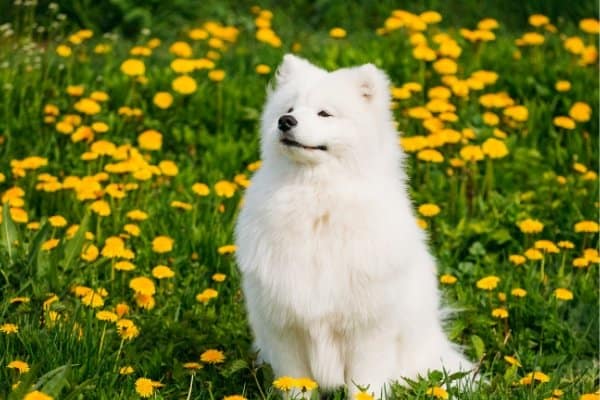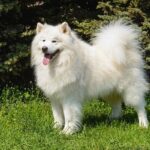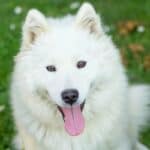Samoyeds are known for their plush, beautiful coats, but are all Samoyeds white? There may be more variety in Samoyed coats than you realize.
Are all Samoyeds white? Not all Samoyeds are white. Bright white is a standard color, but cream, biscuit, and biscuit and white are also accepted by AKC standards. Whatever the color, these lush coats require a fair amount of maintenance to avoid looking dingy.
If you are wondering what your Samoyed’s coat will be like and whether you’ll have to do a lot of maintenance to keep it beautiful and white, we have the answers that you’re looking for.
Samoyed Coats
Samoyeds have lush, double coats. The entire body is covered with a short, thick woolen undercoat. Longer, harsher hair grows through the undercoat and stands out from the body.
The outer coat should not be at all curly. Ideally, the coat should have a silvery sheen. Fur tends to be thicker around the neck and shoulders, especially in males, forming a ruff.
Males generally have longer, harsher coats while females have softer, shorter coats.
Samoyed Colors
Samoyeds are generally thought of as being white dogs, and pure white is certainly accepted by the American Kennel Club, but not all Samoyeds are white.
They can also be biscuit, cream, or white and biscuit.
Any other color will cause a Samoyed to be disqualified according to AKC standards.
Early in the history of the breed, other colors, including black and black and white splotched, were common, and dogs with these colors even won in dog shows.
Dogs with floppy ears were also not unheard of at the time. As time went on, the breed standard solidified into what we know today.
White
White Samoyeds are perfectly pure white from their muzzle to their tail. The black nose, lips, and eyelids contrast sharply against the white coat.
Cream
Cream Samoyeds have a soft tan or beige coloration that is consistent across the entire coat.
The color should not be so deep as to appear golden or red. It should be a gentle tinting to the white of the coat.
Biscuit
Biscuit Samoyeds have slightly darker coloration on the back, shoulders, neck, and ears and cream or white on the stomach, chest, legs, and tail.
Many dogs just have some color in the ears and are still considered Biscuit.
Caring for a Samoyed Coat
The thick, magnificent coat of the Samoyed does not come without a cost. Caring for a Samoyed coat is a time-consuming prospect.
Even with the best care, you will still be left with a fair amount of shed hair around your house and on your clothes.
That said, good care is fundamental to living peacefully with your Samoyed and his coat. Here are some standards for Samoyed coat care.
Environment
A Samoyed’s natural environment is the snow. A Samoyed who is allowed to roll in the snow freely will tend not to get dirty and will clean himself.
However, if you live somewhere with a lot of dirt, your Samoyed will likely dig into the dirt or mud to get cool.
Controlling your environment will go a long way to keeping your Samoyed clean.
Maintenance
Wash your Samoyed’s feet every time he plays in the dirt outside.
Rub the body down with a moist towel and briskly dry to remove dirt from the surface of the coat before it works its way into the skin.
Briefly washing your Samoyed in this way every day will help him to stay cleaner between baths and prevent dirt from being brought into your home.
Brush
It is best to brush your Samoyed frequently, ideally every day, though several times a week can usually suffice.
The more frequently you brush your Samoyed, the less likely it is that mats will be an issue.
Frequent brushing removes dead hair so that your dog will shed less in your house. Brushing also makes your dog look his best and keeps the coat in ideal condition between washings.
Brushes to Have on Hand
Different owners may find different brushes to be appropriate, depending on what kind of mess your dog gets into and exactly what the coat is like, as some are thicker than others.
Whatever brush you choose, stay away from any that cut the hair while they brush. Samoyeds need their double coat to remain intact for temperature control.
- Pin brush -This brush is similar to what most people think of as a normal hairbrush for human hair. A cushioned surface prevents the pressure from being too great. This is a great brush for everyday detangling and casual brushing.
- Undercoat rake – When your dog is shedding profusely, a rake is a great option for breaking up the clumps of shedding hair and gently removing them.
- Comb – A standard comb with widely spaced teeth on one side and narrow ones on the other is a handy tool when trimming the fur between your dog’s pads as well as detangling the tail.
Trim Toenails and Pad Hair
Samoyeds grow thick hair between the pads of their feet. This hair is effective for keeping the pads and the feet warm and offering insulation from the snow.
Hair between the pads makes it more difficult for dogs to grip surfaces like interior floors. Every three weeks or so, trim your dog’s toenails and the hair between the pads.
Keeping your Samoyed’s Coat White
Avoid Sun Exposure
The sun can burn your Samoyed’s coat. A little bit of sun won’t do any harm, but long exposure to intense sunlight is not good for your Samoyed’s coat.
Make sure that your dog always has access to shade.
Whitening Shampoo
A gentle whitening shampoo, like White on White, can help to keep your dog’s coat whiter by brightening any yellow tinge in the coat.
Be sure to use a very gentle shampoo that won’t be harsh on your dog’s coat.
Baking Soda
Baking soda is a gentle way to remove stains and compliment whitening shampoos. It’s a good thing to use if you bathe your dog infrequently or they are especially dingy.
High-Quality Conditioner
A great conditioner keeps the coat in better condition so it will be less likely to be stained or damaged. I’ve seen excellent results with John Paul’s Oatmeal Conditioner.
Tear Stain Remover
Many Samoyeds are prone to tear stains, so it may be a good idea to buy a quality tear stain remover to get rid of any marks or brown spots around the eye.
It is also a good idea to keep the area around your dog’s eyes as dry as possible since the dampness encourages stains.
You can learn more about tear stain causes and treatment here.
Excellent Diet
A high-quality diet will help your Samoyed to grow and maintain a healthy coat that is resistant to staining.
Flaxseed oil and fish oil are both great sources of omega-3 fatty acids that you can keep an eye out for in your dog’s food and supplements.
Related Questions:
Can Samoyeds Have Blue Eyes?
Some Samoyeds may be born with blue eyes, but blue eyes are not accepted by the AKC standard. Samoyeds should have dark, angular eyes that contrast with the light fur.
Can Samoyed Fur Be Used in Knitting?
Samoyed fur is a great alternative to wool in knitting. The texture is generally similar to Angora, with female dogs having a softer texture than males.
This fur is also useful for making artificial flies for fly fishing. Because Samoyed fur is so resistant to cold, sweaters made of the fur can handle temperatures well below freezing.
Why Are Samoyeds White?
Samoyed are white or very light in color because they were bred by a semi-nomadic Asian people who migrated to Siberia, one of the coldest places on Earth, where temperatures of minus 60 degrees are not uncommon.
The Samoyed was bred to pull sleds, hunt, watch over the camp, and keep the people warm in their tents.
Because there was nearly always snow on the ground, the white color helped Samoyeds to blend in with their surroundings, which made them more effective as hunters and watchdogs.
Hungry for more information about this lovely, smiling breed? Head over to our section on Samoyeds to learn more.





